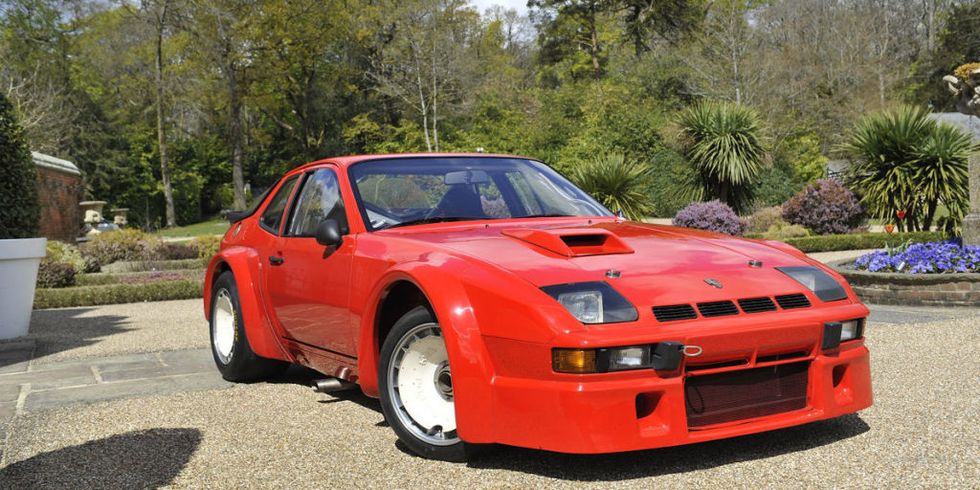(1981) Porsche 924 Carrera GTR – Ultimate Guide
Porsche brought a handful of 924 Carrera GTs to compete in the GTP class in the 1980 Le Mans 24 hour race, with the best car finishing sixth overall. Further development of the Carrera GT platform led to even more homologation specials, culminating in 1981 with the wild 924 Carrera GTR. Ferociously quick, the 924 Carrera GTR was the strongest and fastest—barring only the GTR Le Mans and GTP—of Porsche’s first-generation water-cooled racing cars.
In 1979, Porsche began developing its 924 Turbo as a Group 4 GT entry for the 1980 24 Hours of Le Mans. The new coupe was fitted with a full alloy roll cage and an additional cross-brace beneath the hood. Body panels included aluminum, lightweight urethane and fiberglass. Disc brakes and axles came from the 935 parts bin; a larger intercooler was fitted in the nose; an uprated dog-leg five-speed transmission with limited-slip and its own cooler mounted at the rear gave the chassis exceptional balance. The suspension was fully adjustable, with titanium springs and Bilstein coil-overs front and rear. The dry-sump 2.0-liter inline four developed a startling 375 horsepower with almost 300 pound-feet of torque, giving the 2,050-pound GTR brilliant a 180-mph top speed.
After a trio of 924s made a successful debut in 1980, Porsche came back to Le Mans in 1981 with a single GTR and one 924 GTP powered by a new turbocharged 2.5 engine. Both finished well. Simultaneously, Porsche built 17 customer GTRs with slightly less-powerful engines.
The 924 GTR’s large fender flares covered wide 16-inch center-lock BBS alloy wheels fitted with internally-finned turbine covers to enhance brake cooling. The windshield was of thinner glass, while the lightweight door shells held only a latch mechanism and frames for sliding plastic panels. The interior was all business, virtually identical to the factory racers save for the second bucket seat and harness for a passenger; there was also a fire-suppression system and additional instrumentation.
The customer cars found homes with privateers, and nine of them would add Le Mans appearances to their resumes. Two reportedly went to Japan, including this example, said to have been stored by the importer for two years before acquisition by a Japanese businessman. That individual is believed to have driven it a few times at Suzuka and Fuji; though, there is no record of this car ever having been raced. Otherwise, it was carefully parked at his home for many years, emerging annually for maintenance by Porsche specialists.
Other than a fuel line that has been replaced, this stunning machine is described as exceedingly original and has never been damaged or modified. Eventually offered for sale in the UK, it was subsequently imported to the United States.
Either as the centerpiece of a collection of notable Porsches or to enjoy at club events, this rare 924 GTR presents a unique opportunity not to be missed.
Porsche 924 Carrera GTR at Le Mans
There were no works 911 variants at Le Mans in 1980. In keeping with the company’s move away from the 911*, Porsche entered three works 924 Carrera GTRs into the GTP class, as the first move to make the 924 the Le Mans winning successor to the 934/935 within three or four years. Although down on power (320bhp) against other entrants, the three acquitted themselves well, finishing 6th, 12th, and 13th due to reliability, and excellent handling at a very wet race.
In 1981 Porsche entered a 924 Carrera GTP and a 944 LM, both of which used the new 2.5l engine later used in the 924S and 944. In 1982 924s were entered only by privateers, including two cars entered by BF Goodrich using road tyres. The 924 won the IMSA GTO class in 1981 and the IMSA GT class in 1982, but overall never bettered the Porsche works results, despite the customer cars having more power than the original works cars. After 1980 Porsche focused on mid-engined cars for the new Group C regulations for 1982, dominating the class and ending factory development of the GTR.
The 924 Carrera GTRs used the standard 924 block, (931) cylinder head, crankshaft, and con-rods. The turbo and intercooler were much larger and moved to the inlet side and front of the engine bay respectively. An aluminium torque tube and titanium drive shafts lightened the drive train components. A 935-based gearbox was used.
*Paraphrased from Paul Frere’s excellent book, “Porsche 911 Story”
At the end of 1980, Professor Ernst Fuhrmann (who had been in charge of Porsche’s activities since the end of 1972) resigned from his office one year before his contract expired…Fuhrmann, under whose leadership the Porsche 924, 944, and 928 had been developed, was much more inclined to push these cars than the 911…But Dr Ferry Porsche, who had been the real “father” of the 911, had different views…Professor Fuhrmann’s policy had led to a considerable reduction of the 911 development programme, but as soon as Peter Schutz took office [to Managing Director], in January 1981, the decision was taken to reactivate the development of the model”.











